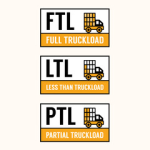
How to Choose the Right Freight Broker in 2025 | SwivelCS Guide
August 13, 2025
LTL vs. FTL Shipping: How to Optimize Costs for Any Load Size
September 11, 2025Dedicated Trucking vs. Spot Market: Which Delivers Better ROI?
A 2025 Shipper’s Guide to Smarter Freight Procurement
Executive Snapshot
In a year of rising operational costs, narrowing contract-to-spot spreads, and a renewed push for predictable service, shippers are re-evaluating how they source capacity. Dedicated trucking services, long associated with cost stability and reliability, offer a clear contrast to the spot market, known for its agility and rate volatility.
This guide examines:
- The differences between spot and dedicated freight models
- How 2025 cost and capacity trends are reshaping ROI
- When each model delivers better results
- How Swivel’s hybrid model optimizes both simultaneously
1. Defining the Two Models
Let’s begin with a clear side-by-side breakdown of the two dominant freight procurement models.
| Model | Characteristics | KPI Focus | Typical Use Cases |
| Dedicated Trucking Services / Contract Freight | Multi-year agreement, guaranteed capacity, indexed or fixed rate, often includes service-level penalties. | Cost predictability, OTIF (On-Time In-Full), CO₂ emissions tracking. | High-volume replenishment, retail MABD, pharmaceutical and temperature-controlled lanes. |
| Spot Market | One-off pricing per load via broker networks or boards. Subject to daily market swings. | Speed to cover, real-time market alignment. | Promotions, seasonal surges, overflow, project freight, backhauls. |
2. 2025 Rate and Capacity Trends Affecting ROI
The gap between contract and spot freight is narrowing in 2025—driven by tightened capacity and increased operating expenses.
Here’s where things stand mid-year:
| Mode | Contract Rate (avg) | Spot Rate (avg) |
| Dry Van | $2.35/mi | $2.06/mi |
| Flatbed | $3.17/mi | $2.61/mi |
| Reefer | $2.71/mi | $2.35/mi |
Source: Uber Freight, June 2025
Additional pressures:
- Driver pay is up 2.7% YoY, doubling last year’s growth rate (NTI).
- Operational costs have hit an all-time high of $2.27 per truck-mile (England Logistics).
- Spot spikes like the July 4th dry van jump (+21.4¢) demonstrate continued volatility.
- DAT reports fewer carriers in market—reducing soft capacity and making contract coverage more appealing.
These trends make fixed capacity via dedicated contracts more attractive for stable lanes, while leaving flexibility on the table for less predictable freight.
3. Calculating ROI Beyond the Line-Haul Rate
Too often, ROI is viewed solely through the lens of rate-per-mile. But logistics leaders know total value extends into risk, service, and administration.
| Cost/Benefit | Dedicated Services | Spot Market |
| Line-Haul Rate | Typically carries a 3–8% premium in soft markets. | Priced by the day; can save 10–15% in downcycles but may surge 20%+ in tight weeks. |
| Capacity Risk | Guaranteed. Avoids tender rejections and urgent expedites. | High. Last-minute rate shopping can cause service gaps. |
| Soft Savings | Fewer claims, reduced detention, better pickup compliance. | None inherently; varies load by load. |
| Inventory Buffering | Minimal. Predictability enables lean JIT systems. | Higher safety stock required to hedge volatility. |
| Admin Load | One contract, quarterly reviews, stable process. | Ongoing paperwork, rate confirmation, load tracking. |
✅ Verdict: Dedicated wins when predictability, service-level penalties, or high-impact freight are in play.
4. When Dedicated Trucking Maximizes ROI
Dedicated isn’t just about cost—it’s about aligning transportation with strategic business goals.
🔹 Recurring, Time-Definite Shipments
Must-arrive-by-date (MABD) retail deliveries are unforgiving. One major U.S. retailer levies chargebacks exceeding $100,000/month for OTIF failures. Studies show dedicated services cut OTIF failures by 30–50% (Lily Transportation).
🔹 High-Service or Regulated Freight
White-glove, hazmat, and pharma shipments benefit from driver familiarity, training, and the avoidance of variable service levels.
🔹 ESG Commitments
Predictable routes enable route optimization, lower empty miles, and Scope 3 CO₂ tracking—ideal for shippers pursuing sustainability reporting.
🔹 Driver Scarcity Zones
Dedicated fleets offer stability for high-friction lanes where seasonal driver churn or regional shortages create capacity gaps.
5. When the Spot Market Wins
While dedicated works for volume and service-sensitive freight, the spot market still shines in three core areas:
🔹 Unplanned Volume Surges
Spikes from promotions, disaster relief, or quarter-end pushes require flexibility—something contracts can’t always stretch to accommodate.
🔹 Low-Volume or Experimental Lanes
Lanes with under 200 loads per year often can’t justify the cost or management complexity of a dedicated setup.
🔹 Down Markets
When spot rates drop 10%+ below contract, temporary savings can be substantial—provided you monitor service impacts and have an agile tendering system.
6. Hybrid Procurement: The Emerging Best Practice
For many shippers in 2025, the answer isn’t either-or—it’s both. Hybrid procurement strategies allow organizations to capitalize on the strengths of dedicated contracts while retaining the agility of the spot market.
🔄 Core Strategy: Dedicated Backbone + Spot Overflow
Lock in 70–80% of your forecastable volume in dedicated or contract freight. Use the spot market to cover:
- Pop-up promotions
- Overflow during peak seasons
- Freight with low volume or inconsistent scheduling
This strategy delivers:
- Rate stability on core lanes
- Flexibility without overcommitting
- Faster coverage when unplanned needs arise
📆 Quarterly “Mini-Bids”
The traditional once-a-year RFP can’t keep up with today’s volatility. Swivel recommends issuing quarterly mini-bids for volatile lanes, allowing you to renegotiate based on the latest market data every 90 days.
Benefits:
- Stay in sync with current spot trends
- Reduce overpaying during downcycles
- Improve leverage with carriers
📊 Data-Driven Trigger Points
Swivel’s technology alerts shippers when lane-specific spot rates fall 5%+ below contract for two consecutive weeks. This real-time intelligence supports automated mode-switching logic.
For example:
- A lane in a low-demand region may temporarily favor spot
- A reefer lane with tight driver availability may warrant dedicated escalation
This dynamic approach ensures every lane is managed for maximum ROI—not just convenience.
7. Swivel’s ROI Model
Swivel’s hybrid optimization engine doesn’t rely on guesswork. It’s built on lane-level simulations, robust forecasting, and machine learning.
📍 Lane-Level Simulation
We analyze your historical freight volumes against:
- DAT-iQ forward curves
- FTR volatility indices
- Regional carrier availability
This projects a 12-month outlook for cost, tender acceptance, and OTIF performance under both dedicated and spot strategies.
🧠 Dedicated Feasibility Scoring
Not all lanes are created equal. Swivel scores each lane using a “Dedicated Fit Index” (0–100) based on:
- Load frequency
- Transit time variability
- Detention/dwell behavior
- Service penalty exposure (e.g., retail OTIF)
High scores = good contract candidates
Low scores = better left to spot or mini-bid strategies
🔄 Continuous Optimization
Even after launch, Swivel’s AI keeps tuning your procurement mix. If:
- A formerly stable lane becomes erratic
- A low-volume lane gains density
- A spot rate drops consistently
…Swivel automatically recommends (or implements) changes to your routing guide.
8. Case Example: Anonymized Consumer Goods Shipper
One national shipper came to Swivel in 2024 with a 100% spot-market strategy. They struggled with:
- High OTIF penalties from big-box retailers
- Unpredictable freight spend
- Carrier reliability issues
After Swivel’s ROI simulation, they adopted a hybrid model:
| Before Swivel | After Hybrid Optimization |
| 100% Spot Freight | 70% Dedicated, 30% Spot |
| $2.78 CPM Blended | $2.65 CPM Blended |
| 85% OTIF | 97% OTIF |
| $840k Chargebacks | $160k Chargebacks |
| Annual ROI Change: — | +8.3% Net Savings |
This strategic shift preserved flexibility but delivered major gains in cost and service.
9. Key Questions to Ask Before Signing a Dedicated Contract
To ensure your dedicated strategy delivers long-term value, here are four essential vetting questions:
❓ How Are Fixed vs. Variable Costs Allocated?
Understand exactly what’s included in your base rate vs. what’s considered an accessorial.
- Are fuel surcharges, detention, and layovers separated or bundled?
- Is your rate indexed to a public benchmark (e.g., DOE fuel index)?
📌 Why it matters: Transparent pricing avoids future disputes and aligns cost expectations.
❓ What Is the Mid-Term Rate Reopener Clause?
Markets shift. Your contract should too.
- Negotiate a reopener clause when spot rates swing more than ±10%
- Ensure either side can trigger a review with reasonable notice
📌 Why it matters: Keeps your agreement fair and adaptive without constant rebidding.
❓ Which KPIs Trigger Gain-Share or Pain-Share?
The best contracts incentivize high performance.
- Consider gain-share for exceeding OTIF benchmarks
- Apply pain-share penalties for late deliveries, poor tracking, or excess detention
📌 Why it matters: Aligns interests around service, not just volume.
❓ What Technology Powers Visibility?
Manual check calls are outdated—and error-prone.
- Does the provider offer real-time GPS, ELD, and milestone data?
- Are updates delivered via API, EDI, or email?
- Can the system integrate with your TMS?
📌 Why it matters: Visibility gaps = higher risk, especially in retail and time-sensitive shipments.
10. Strategic Takeaways for 2025
Let’s bring it all together. Here’s how to make your freight procurement smarter this year:
✅ Use Dedicated Services When:
- Freight is high-volume, predictable, or subject to penalties
- Service, sustainability, or consistency are core priorities
- You want to reduce inventory buffers and detention costs
✅ Leverage the Spot Market When:
- Volumes are unpredictable or seasonal
- Lanes are short-term, low-volume, or experimental
- Market rates dip far below contract
✅ Adopt a Hybrid Strategy When:
- You want the best of both worlds—cost, flexibility, and resilience
- You have the technology to track, evaluate, and shift modes
- You’re ready to elevate procurement from reactive to strategic
Next Steps
🔍 Run a No-Cost Simulation
Let Swivel apply its forecasting engine to your 2024–25 freight data and identify how to unlock ROI lane by lane.
📥 Download the Scorecard
Use our free [Dedicated vs. Spot Lane Evaluation Tool] to classify your network.
📞 Book a Strategy Session
A 30-minute call with our logistics team can uncover 5–10% savings opportunities on your next routing guide.

